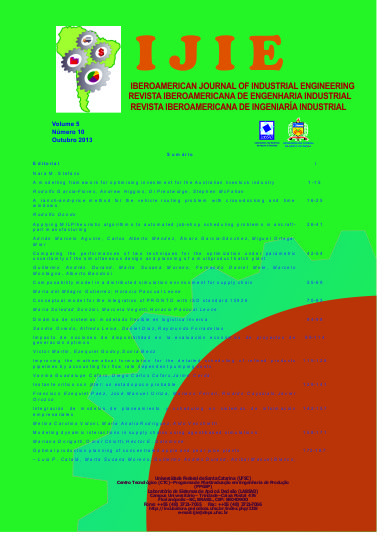Conceptual model for the integration of PRONTO with ISO standard 15926
Palavras-chave:
Interoperability, ISO 15926 Standard, Products family, PRONTO, Semantic webResumo
In this paper a conceptual model based on the ISO 15926 standard is proposed in order to extend and make explicit the representation of product variants given by PRONTO. This extension will allow introducing the product model in a collaborative environment where information systems are able to exchange information with other products systems. Interoperability of systems tends to increase the consistency of models, due to they may have several interpretations. Therefore, the proposal defines new elements and adapts these to the data model of the standard, for a complete concept mapping of PRONTO. Furthermore, changes in the product information are represented in time, through 4D approach.
10.13084/2175-8018.v05n10a06Referências
BALL, A.; DING, L.; PATEL, M. An approach to accessing product data across system and software revisions. Advanced Engineering Informatics, v. 22, p. 222-235, 2008.
BATRES, R.; WEST, M. LEAL, D.; PRICE, D.; MASAKI, K.; SHIMADA, Y.; FUCHINO, T.; NAKA Y. An upper ontology based on ISO 15926. Computers & Chemical Engineering, v. 31, n. 5-6, p. 519-534, 2007.
DATA MODEL ISO 15926. Part 2. Retrieved from: <http://www.infowebml.ws>
GIELINGH, W. An assessment of the current state of product data technologies. Computer-Aided Design, v. 40, p. 750-759, 2008
GOPSILL, J.; MCAPLINE, H.; HICKS, B. Trends in Technology and their Possible Implications on PLM: Looking Towards 2020. Proceedings…, of International Conference on Product Lifecycle Management, 2011.
GRAUBE, M.; PFEFFER, J.; ZIEGLER, J.; URBAS, L. Linked Data as integrating technology for industrial data. Proceedings…, International Conference on Network-Base Information Systems, 2011.
ISO 15926-4. Under the ISO/TS. 2012. Retrieved from: <http://www.caesarsystems.co.uk/iso/ts/15926/-4/tech/reference-data-library/v-0/>
JOHAN W.; KLÜWER, M.G.; SKJÆVELAND, M.V-S. ISO 15926 templates and the Semantic Web. 2008. Retrieved from: <http://www.w3.org/2008/11/ogws-papers/kluwer.pdf>
LEE G.; EASTMAN, C.; SACKS, R. Eliciting information for product modeling using process modeling. Data & Knowledge Engineering, v. 62, p. 292-307, 2007.
LIST OF TEMPLATES. 2013. Retrieved from: <http://www.infowebmlws/TS/TS-details/index.htm>
STEP. Product Data Representation and Exchange-Part 44. Product Structure Conï¬guration. Standard ISO 10303, 1991.
TEMPLATES SPECIFICATION. Retrieved from: <http://15926.org/15926_template_specs.php>.
VALILAI, O.F.; HOUSHMAND, M. A collaborative and integrated platform to support distributed manufacturing system using a service-oriented approach based on cloud computing paradigm. Robotics and Computer-Integrated Manufacturing, v. 29, p.110-127, 2013.
VEGETTI, M.; LEONE, H.; HENNING, G. PRONTO: An ontology for comprehensive and consistent representation of product information. Engineering Applications of Artificial Intelligence, v. 24, n. 8, p. 1305-1327, 2011.
Downloads
Publicado
Como Citar
Edição
Seção
Licença
Os artigos publicados são de propriedade do IJIE – Iberoamerican Journal of Industrial Engineering, Revista Iberoamericana de Engenharia Industrial, Revista Iberoamericana de Ingeniería Industrial. Os autores são os responsáveis pelos conteúdos dos artigos. O IJIE não se responsabiliza ou endossa as opiniões emitidas pelos autores dos textos publicados, salientando que as opiniões são de exclusiva responsabilidade dos autores.
O periódico se reserva o direito de introduzir alterações no original, visando a manter a homogeneidade e a qualidade da publicação, respeitando, no entanto, o estilo e as opiniões dos autores. Essas alterações serão editoriais (correções gramaticais e adequações estilísticas) e não substanciais, de forma que não modifiquem o sentido do texto. As provas finais não serão enviadas aos autores, sendo o artigo publicado com os ajustes necessários.
Conforme citado neste site, no item “Caráter do IJIE”, os artigos são de uso gratuito, com atribuições próprias em aplicações educacionais e não-comerciais. Uma nova publicação do mesmo texto, de iniciativa de seu autor ou de terceiros, fica sujeita à expressa menção da precedência de sua publicação neste periódico, citando-se a edição e a data dessa publicação.

